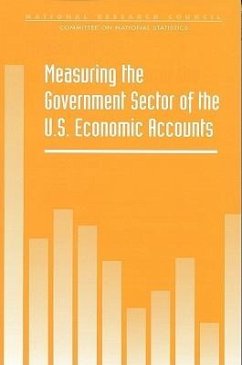
Concepts and Methods of the U.S. Input-Output Accounts

PAYBACK Punkte
11 °P sammeln!
The "Input-Output Handbook" describes the concepts and methods that underlie the preparation of the benchmark input-output (I-O) accounts of the United States. The handbook is intended to provide new employees with a grounding in the basics of I-O accounting, background on the development and uses of the accounts, and an introduction to the process of preparing the I-O estimates and tables. It is also intended to provide existing employees with information that will broaden their understanding of particular aspects of the work. The handbook does not provide detailed descriptions of methodology...
The "Input-Output Handbook" describes the concepts and methods that underlie the preparation of the benchmark input-output (I-O) accounts of the United States. The handbook is intended to provide new employees with a grounding in the basics of I-O accounting, background on the development and uses of the accounts, and an introduction to the process of preparing the I-O estimates and tables. It is also intended to provide existing employees with information that will broaden their understanding of particular aspects of the work. The handbook does not provide detailed descriptions of methodology or of database operations. The descriptions of methodology that are presented in the handbook are primarily based on the 1997 benchmark accounts, though some updates and indications of future changes are included. Thus, the handbook is intended to be a living reference, whereby additional or updated information can be added as available and appropriate. This work has been selected by scholars as being culturally important, and is part of the knowledge base of civilization as we know it. This work was reproduced from the original artifact, and remains as true to the original work as possible. Therefore, you will see the original copyright references, library stamps (as most of these works have been housed in our most important libraries around the world), and other notations in the work. This work is in the public domain in the United States of America, and possibly other nations. Within the United States, you may freely copy and distribute this work, as no entity (individual or corporate) has a copyright on the body of the work. As a reproduction of a historical artifact, this work may contain missing or blurred pages, poor pictures, errant marks, etc. Scholars believe, and we concur, that this work is important enough to be preserved, reproduced, and made generally available to the public. We appreciate your support of the preservation process, and thank you for being an important part of keeping this knowledge alive and relevant.





![The Public School Bookkeeping [microform]: Containing Illustrations of the Latest and Best Methods of Keeping Accounts by Single and Double Entry, Bus Cover The Public School Bookkeeping [microform]: Containing Illustrations of the Latest and Best Methods of Keeping Accounts by Single and Double Entry, Bus](https://bilder.buecher.de/produkte/65/65503/65503860n.jpg)

![Report on the Fur Trade Accounts [microform] Cover Report on the Fur Trade Accounts [microform]](https://bilder.buecher.de/produkte/66/66167/66167062n.jpg)
![The Canadian Accountant [microform]: a Practical System of Book-keeping, Containing a Complete Elucidation of the Science of Accounts by the Latest an Cover The Canadian Accountant [microform]: a Practical System of Book-keeping, Containing a Complete Elucidation of the Science of Accounts by the Latest an](https://bilder.buecher.de/produkte/66/66190/66190078n.jpg)

![Manual of Standard Book-keeping [microform]: a Progressive and Practical Treatise on the Science of Accounts for the School, Business College, and Sel Cover Manual of Standard Book-keeping [microform]: a Progressive and Practical Treatise on the Science of Accounts for the School, Business College, and Sel](https://bilder.buecher.de/produkte/65/65551/65551090n.jpg)
![A Practical Compendium of Accounts [microform], for the Use of Banking, Mercantile, and Other Public Companies, and Accountants, Auditors, and Shareho Cover A Practical Compendium of Accounts [microform], for the Use of Banking, Mercantile, and Other Public Companies, and Accountants, Auditors, and Shareho](https://bilder.buecher.de/produkte/65/65578/65578634n.jpg)
